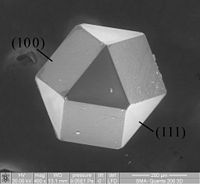
Photo from wikipedia
Abstract Automated mineralogy instrumentation (QEMSCAN, MLA, TIMA) is routinely used for materials characterization in the mining industry. All current techniques identify minerals based on a combination of backscattered electron and… Click to show full abstract
Abstract Automated mineralogy instrumentation (QEMSCAN, MLA, TIMA) is routinely used for materials characterization in the mining industry. All current techniques identify minerals based on a combination of backscattered electron and chemical (energy-dispersive spectroscopy) signals read from the sample. Boundary zones, where two or more minerals are touching, yield signals that reflect a mix of the characteristics of multiple minerals and that may or may not match anything in the mineral database. These phase boundaries, varying in width, are known to cause errors in automated mineralogy analyses, but what mineral and boundary characteristics affect phase boundary width and how much error phase boundaries can cause remain poorly understood. New Monte Carlo modeling of electron-sample interactions at and near phase boundaries shows that the width of the zone of mixed signals, and hence the amount of error, depends on the grain size and texture of the sample; the densities of the minerals and the ionization potentials of their constituent elements; and the position and orientation of the boundary between the minerals, as well as various instrumental factors such as beam accelerating voltage. Error induced by phase boundaries is high when a high accelerating voltage is used to examine fine-grained samples with complex (intergrowth, exsolution) textures that involve low-density minerals with low-ionization-potential elements. Error is low when the sample is coarse-grained, lacks complex textural relationships that create boundary area, and consists of high-density minerals with high-ionization-potential elements, which have a higher electron stopping power and prevent the beam from spreading out as much. Where low- and high-density minerals are in contact at an angled boundary, the width of the boundary zone is low when the high-density mineral is on top and high when the low-density phase is on top. Calculations based on these simulations indicate that the amount of area that could fall within phase boundary zones depends strongly on grain size, shape, and width of boundary zone. Boundary phases may contribute significantly to overall analytical error for fine-grained minerals with low densities and composed of elements with low ionization potentials, but for most samples the boundary phase area is likely to be
Journal Title: Minerals Engineering
Year Published: 2020
Link to full text (if available)
Share on Social Media: Sign Up to like & get
recommendations!